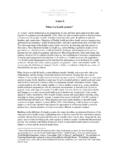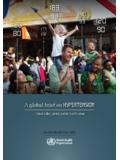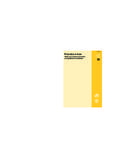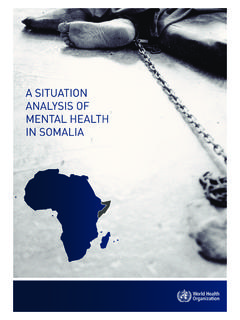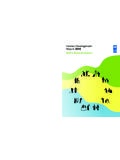Transcription of World Report on Disability - UNICEF
1 World Report ON DISABILITYWHO Library Cataloguing-in-Publication DataWorld Report on Disability persons - statistics and numerical data. persons - rehabilitation. of health care. children. , Special. , Supported. policy. health 978 92 4 156418 2(NLM classification: HV 1553)ISBN 978 92 4 068521 5 (PDF)ISBN 978 92 4 068636 6 (ePUB)ISBN 978 92 4 068637 3 (Daisy) World health Organization 2011 All rights reserved. Publications of the World health Organization are available on the WHO web site ( ) or can be purchased from WHO Press, World health Organization, 20 Avenue Appia, 1211 Geneva 27, Switzerland (tel.)
2 : +41 22 791 3264; fax: +41 22 791 4857; e-mail: Requests for permission to reproduce or translate WHO publications whether for sale or for noncommercial distribution should be addressed to WHO Press through the WHO web site ( ).The designations employed and the presentation of the material in this publication do not imply the expression of any opinion whatsoever on the part of the World health Organization concerning the legal status of any country, territory, city or area or of its authorities, or concerning the delimitation of its frontiers or boundaries.
3 Dotted lines on maps represent approximate border lines for which there may not yet be full mention of specific companies or of certain manufacturers products does not imply that they are endorsed or recommended by the World health Organization in preference to others of a similar nature that are not mentioned. Errors and omissions excepted, the names of proprietary products are distinguished by initial capital reasonable precautions have been taken by the World health Organization to verify the information contained in this publication.
4 However, the published material is being distributed without warranty of any kind, either expressed or implied. The responsibility for the interpretation and use of the material lies with the reader. In no event shall the World health Organization be liable for damages arising from its in MaltaiiiiiiContentsForewordixPreface xiAcknowledgementsxiiiList of contributorsxvIntroduction xxiUnderstanding disability1 What is Disability ?3 Environment4 The diversity of disability7 Prevention8 Disability and human rights9 Disability and development10 Disability a global picture19 Measuring disability21 Prevalence of Disability difficulties in functioning24 Country-reported Disability prevalence25 Global estimates of Disability prevalence25 health conditions32 Trends in health conditions associated with disability32 Demographics34 Older persons34 Children36 The environment37 health conditions are affected by environmental factors37 Disability and poverty39 Developed
5 Countries39 Developing countries39 Needs for services and assistance40ivCosts of disability42 Direct costs of disability43 Indirect costs44 Conclusion and recommendations44 Adopt the ICF45 Improve national Disability statistics45 Improve the comparability of data46 Develop appropriate tools and fill the research gaps46 General health care 55 Understanding the health of people with disabilities57 Primary health conditions57 Risk of developing secondary conditions58 Risk of developing co-morbid conditions59 Greater vulnerability to age-related conditions59 Increased rates of health risk behaviours59 Greater risk of being exposed to violence59 Higher risk of unintentional injury60 Higher risk of premature death60 Needs and unmet needs60 Addressing barriers to health care62 Reforming policy and legislation65 Addressing barriers to financing and affordability66 Addressing barriers to service delivery70 Addressing human resource barriers77 Filling gaps in data and research80 Conclusion and recommendations81 Policy and legislation82 Financing and affordability 82
6 Service delivery 82 Human resources 83 Data and research83 Rehabilitation 93 Understanding rehabilitation95 Rehabilitation measures and outcomes95 Rehabilitation medicine97 Therapy100 Assistive technologies101 Rehabilitation settings101 Needs and unmet needs102 Addressing barriers to rehabilitation103 Reforming policies, laws, and delivery systems104 National rehabilitation plans and improved collaboration105 Developing funding mechanisms for rehabilitation106vIncreasing human resources for rehabilitation108 Expanding education and training110 Training existing health -care personnel in rehabilitation111 Building training capacity112 Curricula content112 Recruiting and retaining rehabilitation personnel112 Expanding and decentralizing service delivery114 Coordinated multidisciplinary rehabilitation114 Community-delivered services114 Increasing the use and
7 Affordability of technology117 Assistive devices117 Telerehabilitation118 Expanding research and evidence-based practice119 Information and good practice guidelines120 Research, data, and information121 Conclusion and recommendations121 Policies and regulatory mechanisms122 Financing122 Human resources122 Service delivery122 Technology123 Research and evidence-based practicF12 3 Assistance and support 135 Understanding assistance and support138 When are assistance and support required?139 Needs and unmet needs139 Social and demographic factors affecting demand and supply140 Consequences for caregivers of unmet need for formal support services141 Provision of assistance and support 142 Barriers to assistance and support 144 Lack of funding144 Lack of adequate human resources144 Inappropriate policies and institutional frameworks145 Inadequate and unresponsive services145 Poor service coordination145 Awareness, attitudes.
8 And abuse147 Addressing the barriers to assistance and support147 Achieving successful deinstitutionalization147 Creating a framework for commissioning effective support services149 Funding services149 Assessing individual needs150 Regulating providers151 Supporting public-private-voluntary services151viCoordinating flexible service provision152 Building capacity of caregivers and service users155 Developing community-based rehabilitation and community home-based care156 Including assistance and support in Disability policies and action plans156 Conclusion and recommendations157 Support people to live and participate in the community157 Foster development of the support services infrastructure157 Ensure maximum consumer choice and control158 Support families as assistance and support providers158 Step up training and capacity building158 Improve the quality of services159 Enabling environments 167 Understanding access to physical and information environments170 Addressing the barriers in buildings and roads172 Developing effective policies173 Improving
9 Standards173 Enforcing laws and regulations175 The lead agency175 Monitoring175 Education and campaigning176 Adopting universal design177 Addressing the barriers in public transportation178 Improving policies179 Providing special transport services and accessible taxis179 Universal design and removing physical barriers 180 Assuring continuity in the travel chain182 Improving education and training183 Barriers to information and communication183 Inaccessibility184 Lack of regulation185 Cost185 Pace of technological change186 Addressing the barriers to information and technology186 Legislation and legal action186 Standards188 Policy and programmes189 Procurement190 Universal design191 Action by industry191 Role of nongovernmental organizations192viiConclusion and recommendations193 Across domains of the environment193 Public accommodations building and roads194 Transportation194 Accessible information and communication195 Education 203 Educational participation and children with disability206 Understanding education and disability209 Approaches to educating children
10 With disabilities210 Outcomes211 Barriers to education for children with disabilities212 System-wide problems212 School problems215 Addressing barriers to education216 System-wide interventions217 School interventions220 The role of co










